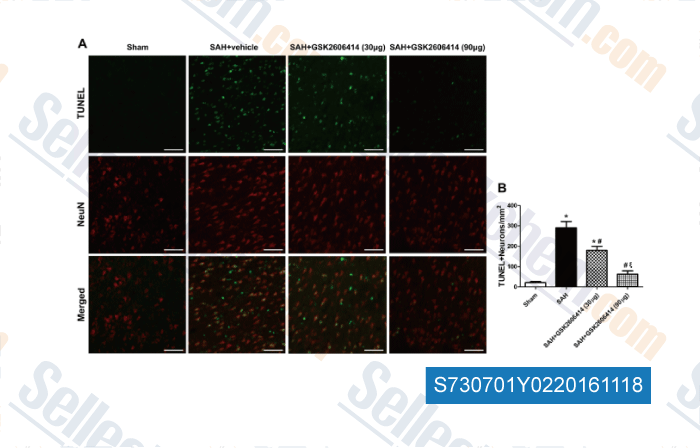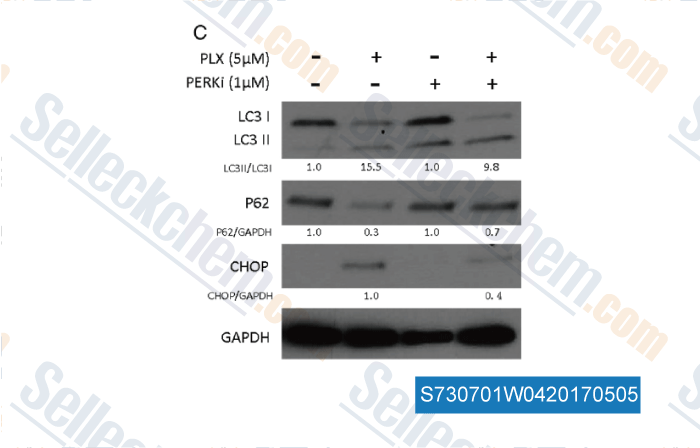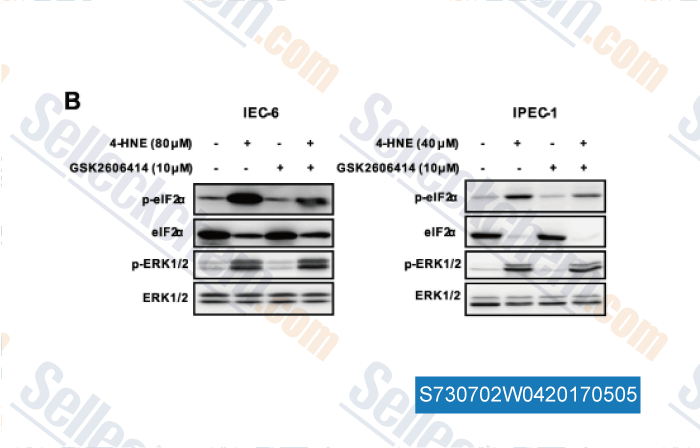|
Toll Free: (877) 796-6397 -- USA and Canada only -- |
Fax: +1-832-582-8590 Orders: +1-832-582-8158 |
Tech Support: +1-832-582-8158 Ext:3 Please provide your Order Number in the email. |
Technical Data
| Formula | C24H20F3N5O |
|||
| Molecular Weight | 451.44 | CAS No. | 1337531-36-8 | |
| Solubility (25°C)* | In vitro | DMSO | 90 mg/mL (199.36 mM) | |
| Ethanol | 19 mg/mL (42.08 mM) | |||
| Water | Insoluble | |||
|
* <1 mg/ml means slightly soluble or insoluble. * Please note that Selleck tests the solubility of all compounds in-house, and the actual solubility may differ slightly from published values. This is normal and is due to slight batch-to-batch variations. * Room temperature shipping (Stability testing shows this product can be shipped without any cooling measures.) |
||||
Preparing Stock Solutions
Biological Activity
| Description | GSK2606414 is an orally available, potent, and selective PERK inhibitor with IC50 of 0.4 nM, displaying at least 100-fold selectivity over the other EIF2AKs assayed. GSK2606414 impairs GANT-61 induced autophagy in NB cells with MYCN amplification. GSK2606414 exacerbates ER stress-induced apoptosis in HCT116 cells while reduces the apoptosis in SIL1 KD HeLa cells. | ||
|---|---|---|---|
| Targets |
|
||
| In vitro | GSK2606414 inhibits PERK Autophosphorylation in A459 Cells with IC50 of <0.3 μM. [1] |
||
| In vivo | GSK2606414 exhibits high oral availability, and low to moderate blood clearance in mouse, rat, and dog. GSK2606414, administered orally, inhibits tumor growth in a dose-dependent manner in mice bearing pancreatic human BxPC3 tumors. [1] |
||
| Features | The first PERK-selective inhibitor with good oral bioavailability and crosses the blood-brain barrier. |
Protocol (from reference)
| Kinase Assay: |
|
|---|---|
| Cell Assay: |
|
| Animal Study: |
|
Customer Product Validation

-
, , Mol Neurobiol, 2016, 54(3):1808-1817

-
Data from [Data independently produced by , , J Neurosci, 2018, 38(9):2372-2384]

-
Data from [Data independently produced by , , J Clin Endocrinol Metab, 2017, 102(2):634-643]

-
Data from [Data independently produced by , , Sci Rep, 2016, 6:32929]
Selleck's GSK2606414 has been cited by 85 publications
| Nucleus pulposus cells regulate macrophages in degenerated intervertebral discs via the integrated stress response-mediated CCL2/7-CCR2 signaling pathway [ Exp Mol Med, 2024, 56(2):408-421.] | PubMed: 38316963 |
| A RIPK3-independent role of MLKL in suppressing parthanatos promotes immune evasion in hepatocellular carcinoma [ Cell Discov, 2023, 9(1):7] | PubMed: 36650126 |
| Nitric oxide-induced ribosome collision activates ribosomal surveillance mechanisms [ Cell Death Dis, 2023, 14(7):467] | PubMed: 37495584 |
| Nitric oxide-induced ribosome collision activates ribosomal surveillance mechanisms [ Cell Death Dis, 2023, 14(7):467] | PubMed: 37495584 |
| IRE1α arm of unfolded protein response in muscle-specific TGF-β signaling-mediated regulation of muscle cell immunological properties [ Cell Mol Biol Lett, 2023, 28(1):15] | PubMed: 36849929 |
| Large HBV Surface Protein-Induced Unfolded Protein Response Dynamically Regulates p27 Degradation in Hepatocellular Carcinoma Progression [ Int J Mol Sci, 2023, 10.3390/ijms241813825] | PubMed: 37762128 |
| Acetylshikonin induces apoptosis through the endoplasmic reticulum stress-activated PERK/eIF2α /CHOP axis in oesophageal squamous cell carcinoma [ J Cell Mol Med, 2023, 10.1111/jcmm.18030] | PubMed: 37929884 |
| High-Content and High-Throughput Clonogenic Survival Assay Using Fluorescence Barcoding [ Cancers -Basel), 2023, 15(19)4772] | PubMed: 37835466 |
| PERK/ATF4-dependent expression of the stress response protein REDD1 promotes proinflammatory cytokine expression in the heart of obese mice [ Am J Physiol Endocrinol Metab, 2023, 324(1):E62-E72] | PubMed: 36383638 |
| Nifuroxazide induces the apoptosis of human non‑small cell lung cancer cells through the endoplasmic reticulum stress PERK signaling pathway [ Oncol Lett, 2023, 25(6):248] | PubMed: 37153034 |
RETURN POLICY
Selleck Chemical’s Unconditional Return Policy ensures a smooth online shopping experience for our customers. If you are in any way unsatisfied with your purchase, you may return any item(s) within 7 days of receiving it. In the event of product quality issues, either protocol related or product related problems, you may return any item(s) within 365 days from the original purchase date. Please follow the instructions below when returning products.
SHIPPING AND STORAGE
Selleck products are transported at room temperature. If you receive the product at room temperature, please rest assured, the Selleck Quality Inspection Department has conducted experiments to verify that the normal temperature placement of one month will not affect the biological activity of powder products. After collecting, please store the product according to the requirements described in the datasheet. Most Selleck products are stable under the recommended conditions.
NOT FOR HUMAN, VETERINARY DIAGNOSTIC OR THERAPEUTIC USE.
